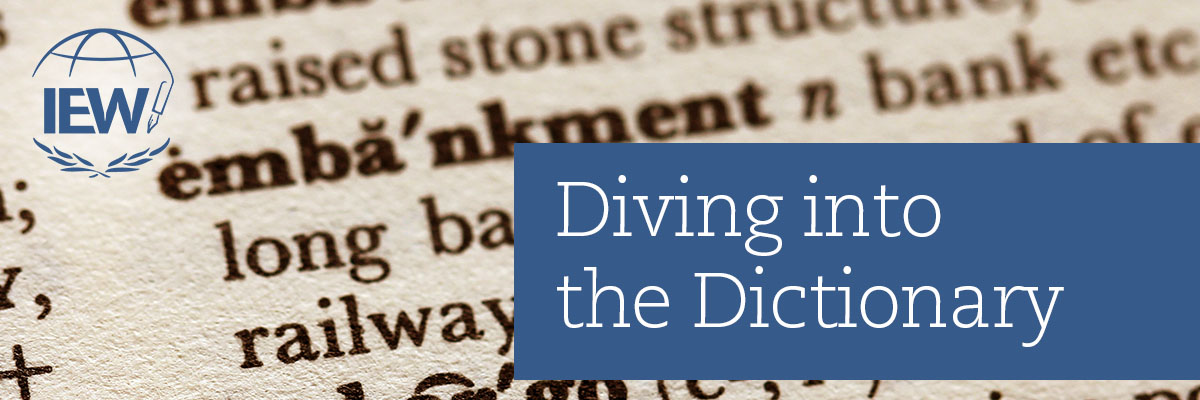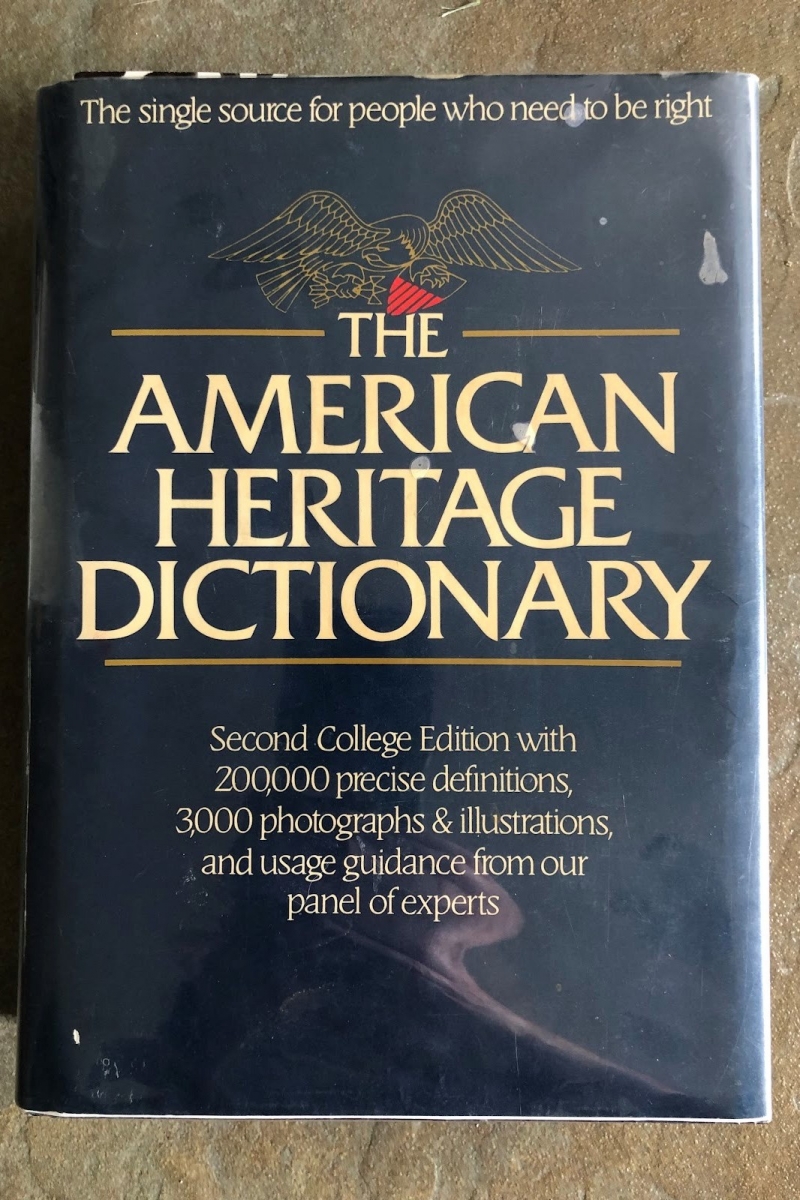
When was the last time you pulled a dictionary off the shelf to look up a word? For many of us, I suspect the answer would be, “I don’t remember.” That’s unfortunate. While it is true that asking Siri, Alexa, or Google to define the word penumbra or spell the word criterion is pretty much commonplace these days, printed dictionaries offer delights beyond simply looking up a spelling or meaning. I’ll be getting fairly technical in this blog post, but I know that not everyone gets as excited as I do about reference materials. If you are one of those people, I understand. Feel free to gloss through this post. But for the rest of us out there who love to page through a thesaurus, pore over a concordance, or invest in a shelf full of specialty dictionaries, I dedicate this post to you.
Although I tried to keep this post light and entertaining, I did dive a little deeply into some of the more esoteric components. I hope you’ll bear with me anyway because dictionaries are pretty nifty resources. I quite love them!
With that thought in mind, let’s take a look at just a few of the fascinating features found in dictionaries. There are too many to address in one post, but hopefully this brief exploration will inspire you to investigate your own dictionary a bit more thoroughly. At the end of the post, I’ll provide some links to a few dictionaries we have recommended. Are you ready? Let’s dive in!
Grab a dictionary from your shelf. Yours will likely differ from mine but should have many common features. Open it up to the beginning. You should find a page near the front that lists what is included in the book. My dictionary, The American Heritage Dictionary, says “Contents” at the top of the page. It has some unexpected sections, including one listing four-year colleges and universities as well as one listing two-year schools. It also has sections titled “Biographical Entries” and “Geographic Entries.” Yours may or may not have similar segments. It may also have other selections that mine does not.
One feature it will have, however, is a guide. The guide, which appears near the front of the book, explains how the content is arranged. While it is commonly known that the words in a dictionary are listed alphabetically, did you know, for example, that most dictionaries arrange their senses, which are the various meanings a word or a phrase may have and which are listed separately under the entry, by frequency of usage? That being said, however, not all do. The Oxford English Dictionary, widely known as the most comprehensive single compendium of English words in the world, arranges its definitions in chronological order, beginning with the oldest. Knowing what arrangement your dictionary utilizes will help you more quickly locate the appropriate definition for the word you are researching.
In the case of my dictionary, it’s not history or frequency; rather, it’s the editor’s idea of what is most useful that dictates the order of appearance. It is handy to understand that just because a definition is listed first, it doesn’t necessarily mean it is the most significant, accurate, or relevant to your situation. You will need to analyze the entry to make that determination.
Zooming in on a random page in your dictionary, you will notice a few features. At the top of the page, you should see two words. These two words are called “guide words” and serve to provide an alphabetical range of all the words contained on the page. Opening up my book to a random page, I see the guide words homozygous and honour across the top. All of the words contained on that page fit within those two words alphabetically. Looking at the word honor reveals that there are thirteen various definitions as well as a section containing synonyms for the word. Some of the synonyms listed include reverence, veneration, and homage.
The word honor is bold and separated into two sections divided by a dot: hon・or. Immediately to the right of that is its phonetic pronunciation, which is listed in parenthesis: (ŏn՛ər). Referencing my guide again, I discover that the dot indicates a suitable place for hyphenating the word at the end of a line. This does not necessarily align with the spoken syllable division. Oftentimes the division dot actually aligns with the word’s morphology. To view the spoken syllable division, I need to look back at the phonetic pronunciation symbols in the parenthesis.
As I read through the various senses (meanings), I notice that some italicized phrases are included after a sense. These indicate idioms. One idiom that appears after the sense “a source or cause of credit” is “was an honor to the profession.” Because idioms need to be taken as a whole to be understood, the editors included a complete phrase to help me grasp its meaning.
A dictionary also provides grammatical information, and mine is no different. I can see the first listing of the word indicates it is describing honor the noun with an italicized n. Down the list I see another grammatical term, tr. v., which indicates the word is being used as a transitive verb in that particular sense.
At the end of the listing, I notice something else interesting. There is a bracket that contains the following: [ME < OFr. < Lat.]. This describes the word’s etymology, its family history. It begins with the word’s most recent history and travels back through time. In this example, the word honor came to us by way of Middle English from Old French via Latin. It is fascinating to investigate a word’s family tree and see how it has evolved over time.
These features barely scratch the surface of all of the information my dictionary yields, but it’s a start. I never even mentioned all of the images displayed on the edges of the pages that provide pictorial information about some of the words listed. On this page alone there are four: images of a honeycomb, honeyeater, honey guide, and honeysuckle. If a picture is worth a thousand words, my dictionary is loaded with thousands upon thousands of words beyond the ones that are simply typed out.
I hope I’ve inspired you to take a closer look at a dictionary. It would be interesting to take an informal poll of your students. How many of them have ever cracked a dictionary? Even better, have them dust off a dictionary to bring to class. Together, take time to look up a word and notice all of the other extra facts that you can learn about it beyond a simple definition. Maybe you will inspire a student to actually consult one from time to time. While an app is a great way to connect quickly with a spelling or a definition and is often the most practical way to research a word, a dictionary can be an entertaining and delightful diversion that teaches us more about words and our world.

Jennifer’s much loved and oft consulted dictionary
If you don’t have a dictionary on your shelf to consult, you may want to consider acquiring one. Take a look at these possibilities, which are ones we have recommended in the past.
-
The American Heritage Desk Dictionary and Thesaurus is a great resource for high school students and adults.
-
The American Heritage Student Dictionary works well for middle school students.
-
The American Heritage Children’s Dictionary is a suitable selection for elementary students.
The Clear and Simple Thesaurus Dictionary is a recommended resource for students working through All Things Fun & Fascinating.
|
Jennifer Mauser has always loved reading and writing and received a B.A. in English from the University of Kansas in 1991. Once she and her husband had children, they decided to homeschool, and she put all her training to use in the home. In addition to homeschooling her children, Jennifer teaches IEW classes out of her home, coaches budding writers via email, and tutors students who struggle with dyslexia. |

